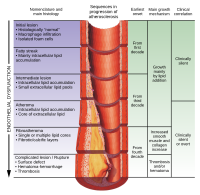
Photo from wikipedia
AIMS Accumulation of mononuclear phagocytes (monocytes, macrophages and dendritic cells) in the vessel wall is a hallmark of atherosclerosis. Using integrated single-cell analysis of mouse and human atherosclerosis, we here… Click to show full abstract
AIMS Accumulation of mononuclear phagocytes (monocytes, macrophages and dendritic cells) in the vessel wall is a hallmark of atherosclerosis. Using integrated single-cell analysis of mouse and human atherosclerosis, we here aimed to refine the nomenclature of mononuclear phagocytes in atherosclerotic vessels, and to compare their transcriptomic profiles in mouse and human disease. METHODS AND RESULTS We integrated 12 scRNA-seq datasets of immune cells isolated from healthy or atherosclerotic mouse aortas, and data from 11 patients (n = 4 coronary vessels, n = 7 carotid endarterectomy specimens) from two studies. Integration of mouse data identified subpopulations with discrete transcriptomic signatures within previously described populations of aortic resident (Lyve1), inflammatory (Il1b), as well as foamy (Trem2hi) macrophages. We identified unique transcriptomic features distinguishing aortic intimal resident macrophages from atherosclerosis-associated Trem2hi macrophages. Also, populations of Xcr1+ type 1 classical dendritic cells (cDC1), Cd209a+ cDC2 and mature DCs (Ccr7, Fscn1) with a 'mregDC' signature were detected. In humans, we uncovered macrophage and dendritic cell populations with gene expression patterns similar to those observed in mice. In particular, core transcripts of the foamy/Trem2hi signature (TREM2, SPP1, GPNMB, CD9) mapped to a specific population of macrophages in human lesions. Comparison of mouse and human data and direct cross-species data integration suggested transcriptionally similar macrophage and dendritic cell populations in mice and humans. CONCLUSIONS We refined the nomenclature of mononuclear phagocytes in mouse atherosclerotic vessels, and show conserved transcriptomics features of macrophages and dendritic cells in atherosclerosis in mice and humans, emphasizing the relevance of mouse models to study mononuclear phagocytes in atherosclerosis.
Journal Title: Cardiovascular research
Year Published: 2022
Link to full text (if available)
Share on Social Media: Sign Up to like & get
recommendations!